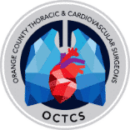An atrial septal defect, also known as ASD, is a congenital heart defect that involves an abnormal opening in the wall separating the two upper chambers, or atria, of the heart. This defect causes blood to flow between the left and right sides of the heart, allowing oxygenated and deoxygenated blood to mix which may result in heart failure, arrhythmia, stroke or pulmonary hypertension.
It is possible for small defects in the atrial septal wall to close on their own, or to exist with no problems to the patient. Larger defects, or those causing symptoms, however, require surgical repair.
Diagnosis of Atrial Septal Defect
The first indication of an atrial septal defect, unless it is diagnosed prenatally, is the sound of a heart murmur through the physician‘s stethoscope. Other diagnostic tests must be perfomed to confirm the diagnosis and to pinpoint the problem. These may include:
- Echocardiogram
- Chest X-ray
- Electrocardiogram
- Cardiac Catheterization
CT and MRI scans may also be performed to view images of the internal structures of the heart.
What People Say About Us!
"Doctor Tang is amazing, he took the time to explained my surgical options, I would recommend him to family and friends"
Click here to read more reviews.
Types of Atrial Septal Defect Repair
Although the physician may detect the atrial septal defect through a heart murmur heard in the stethoscope, the symptoms of an atrial septal defect may not show up until the patient is an adult. If a patient suffers from extreme fatigue, shortness of breath, palpitations, repeated lung infections or other symptoms, surgery is almost always recommended. Proactive surgery may be performed on an infant or a young child. There are three types of atrial septal defect repair:
- Open
- Robotic-assisted
- Catheter-based
While catheter-based atrial septal defect repair surgery is the least invasive of the three, it may not be appropriate in all cases. There are times when open heart surgery, with or without robotic assistance, is necessary to make the repair.
Risks of Atrial Septal Repair
Atrial septal repair is a relatively safe procedure, however, post-surgical complications are possible. These may include:
- Excessive bleeding
- Blood clots
- Adverse reactions to anesthesia or medications
- Post-surgical infection
- Damage to adjacent organs
- Breathing difficulties
- Hernia at the incision site
There is also the possibility of pericarditis, an inflammation of the sac surrounding the heart, after atrial septal repair.
Recovery After Atrial Septal Repair
Regardless of the method - either traditional or robot-assisted, recovery from heart surgery will take 4 to 6 weeks. For a patient for whom the catheter-based operation is possible, recovery time will be shorter. Most atrial septal repair surgeries are successful and improve the patient‘s quality of life as well as increasing the patient‘s life span.
During the period immediately after atrial septal repair surgery, patients are advised to avoid strenuous activity and heavy lifting. They may also be prescribed antibiotics and blood thinners to avoid complications.

